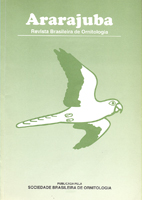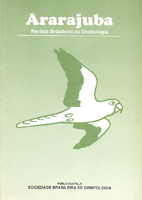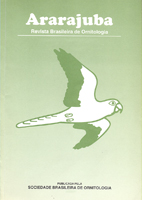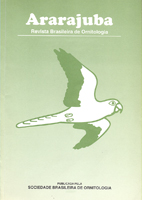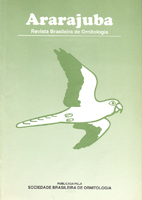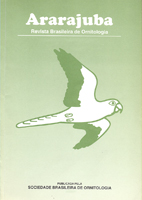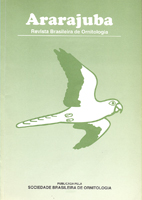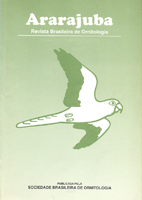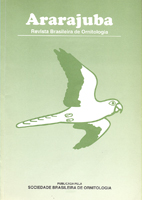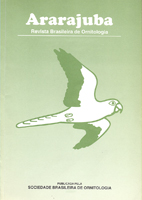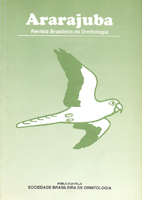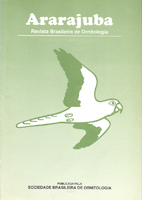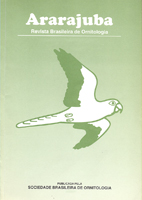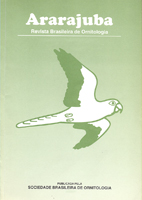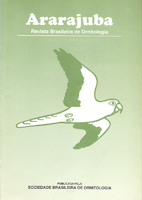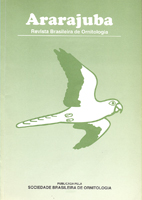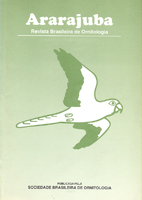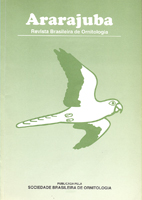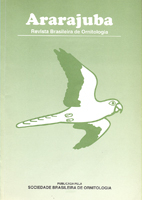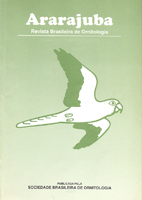Volume 5, Number 2 - December 1997
Editor: Miguel Angelo Marini
Belo Horizonte, MG
Pages: 172
Editor: Miguel Angelo Marini
Belo Horizonte, MG
Pages: 172
Full Issue
| View or download the full issue |
Table of Contents
Article
| Rediscovery of the White-cheeked Parrot Amazona kawalii (Grantsau and Camargo, 1989), with notes on its ecology, distribution, and taxonomy. | ||
| Paulo Martuscelli, Carlos Yamashita | 17 |
| Seasonal abundance and feeding ecology of parrots and parakeets in a lowland Atlantic Forest of Brazil. | ||
| Mauro Galetti | 12 |
| DNA fingerprinting applied to parrot captive breeding programs. | ||
| Cristina Yumi Miyaki, Sérgio Luiz Pereira, Iara Biasia, Anita Wajntal | 7 |
| Extra-pair paternity in the Golden Conure (Guaruba guarouba) (Psittacidae: Psittaciformes) detected in captivity. | ||
| Cristina Yumi Miyaki, Felipe Becker Albertani, Anita Wanjtal | 5 |
| The Blue-throated Macaw Ara glaucogularis: characterization of its distinctive habitats en savannahs of the Beni, Bolivia. | ||
| Carlos Yamashita, Yuri Machado de Barros | 10 |
| Nest characteristics of the Red-spectacled Amazon Amazona pretrei Temminck, 1830 (Aves, Psittacidae). | ||
| Nêmora Pauletti Prestes, Jaime Martinez, Paulo André Meyrer, Luiz Henrique Hansen, Marcelo de Negri Xavier | 8 |
| Muestreos del comercio de psitácidos neotropicales en la ciudad de Barcelona, España: 1991-1996. | ||
| Juan Carlos Guix, Lluíz Jover, Xavier Ruíz | 9 |
| Vertical stratification and diet of psittacids in a tropical lowland forest of Brazil. | ||
| Marco Aurélio Pizo, Flávio Antônio Maes dos Santos, Isaac Simão | 6 |
| Guild birds Bowdichia virgilioides (Fabacea, Faboideae) in cerrado Furnas, Minas Gerais. | ||
| Rosario Rojas, Rômulo Ribon | 6 |
| Exclusion geographical and ecological Penelope obscura, and Penelope superciliaris Pipile jacutinga (Galliformes: Cracidae) in the state of São Paulo. | ||
| Juan Carlos Guix | 8 |
| Ecology and behavior of wintering Falco peregrinus (Falconiformes: Falconidae) in southeastern Brazil. | ||
| Robson Silva Silva | 6 |
| Birds of the Abrolhos Archipelago, Bahia, Brazil. | ||
| Vania Alves, Ana Beatriz Soares, Gilberto Couto, Ana Beatriz Ribeiro, Marcio Efe | 10 |
| The use of tartar emetic in the study of feeding wild birds in the state of Rio de Janeiro. | ||
| Francisco Mallet Rodrigues, Vania Soares Alves, Maria Luíza Marinho Noronha | 10 |
Note
| Use of tree cavities for roosting by the Reddish-bellied Parakeet (Pyrrhura frontalis). | ||
| Giane Chaves Kristosch | 2 |
| Anodorhynchus macaws as followers of extinct megafauna: an hypothesis. | ||
| Carlos Yamashita | 8 |
| Nest and egg description of an endemism of the Brazilian north-east: the Cactus Parakeet, Aratinga cactorum. | ||
| Luciano Nicolás Naka | 4 |
| On the Hyacinth macaw's nesting tree: density of young manduvis around adult trees under three different management conditions in the Pantanal wetland, Brazil. | ||
| Marc Aeron Johnson, Walfrido Moraes Tomas, Neiva Maria Robaldo Guedes | 4 |
| Use of artificial perches and islands of vegetation by birds dispersing seeds | ||
| Marcelino Carneiro Guedes, Valério Andrade Melo, James Jackson Griffith | 4 |
| Evidence for the possible advantage of heterospecific social foraging in Furnarius rufus (Passeriformes: Furnariidae). | ||
| José Ragusa Netto | 3 |
| First report of Xenus cinereus (Charadriiformes: Scolopacidae) for Brazil. | ||
| Juan Mazar Barnett | 2 |
| Aspects of the nesting bacurauzinho, Chordeiles pusillus (Caprimulgiformes: Caprimulgidae) in the states of Bahia and Minas Gerais. | ||
| Marcelo Ferreira Vasconcelos, Lemuel Olívio Leite, Luciano Nicolás Naka, Marcos Maldonado Coelho | 4 |
| New distributional information for 25 species in eastern Paraguay. | ||
| Juan Mazar Barnett, James Lowen, Mark Pearman, Rob Clay, Bernabé López Lanú | 4 |
| New records of nests and eggs of three species of birds of Central Brazil. | ||
| Miguel Ângelo Marini, Maria Fátima Pereira, Genilda Maria Oliveira, Celine Melo | 2 |
| Nest building and early incubation in Squirrel Cuckoos (Piaya cayana). | |
| yoshika oniki, Edwin O. Willis | 3 |
** The work of the Editor in Chief, Managing Office, Associate Editors, and the Editorial Council of Revista Brasileira de Ornitologia is strictly voluntary, and does not involve the use of any resources and infrastructure other than the personal ones**




